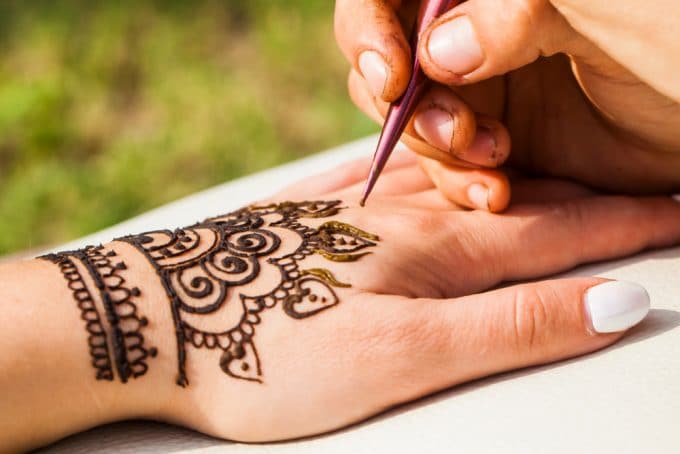In 2018, a 7-year-old girl suffered horrific chemical burns that may have scarred her body for life – all because of a temporary henna tattoo.

Not to be an alarmist, but I think we all know dangerous things are lurking everywhere. It’s a terrifying notion for parents. You can’t protect them from bad things if you didn’t know it was bad!
Some dangers are in plain sight. Others are harder to see. Chemicals are one of the hazards for our children that we sometimes overlook. (In sunscreen, for example.)
Even if you think you and your kids will never get a henna tattoo, I hope you’ll read this because the chemical that burned this child is already in your everyday life
Chemical Burns
A chemical burn is irritation and destruction of human tissue caused by exposure to a chemical, usually by direct contact with the chemical or its fumes. (source)
Little Madison and her family were vacationing in Egypt when they learned first hand how brutal a burn like this can be. The family was staying in a beautiful 4-star hotel for vacation when Mom suffered a gall bladder infection.
Dad, looking for fun things to do with the kids I’m sure, let them get temporary tattoos. They were the henna tattoos that are so beautiful to look at, and they were supposed to wash off.
Madison’s little brother Sebastien was the first to experience trouble with the henna ink. His skin began itching so they washed it off right away. It wasn’t long before she began having problems as well, but hers was so much worse.
She wound up with blisters from her finger to her elbow and her pain was excruciating. Doctors diagnosed her as having chemical burns from an ingredient in the henna ink.
Paraphenylenediamine was the culprit
This chemical is something you’ve almost certainly been in contact with before, even if you didn’t know it. It can be found in hair dye and is the reason you should always do a patch test if you color at home. In the US, henna is only approved for use in hair dye.
If you’ve ever been to certain areas on vacation, like touristy spots and beaches, for example, these kinds of tattoo artists are everywhere. Unfortunately, you won’t know whether the chemical is in the henna and honestly, I truly doubt the person doing the inking does either.
You’ll also find paraphenylenediamine in the following.
Textile dyes and fur dyes
Dark colored cosmetics
Dark colored temporary henna tattoos
Photographic developer and lithography plates
Photocopying and printing inks
Black rubber
Oils, greases, and gasoline. (source)
From US National Library of Medicine and National Institutes of Health:
The addition of paraphenylenediamine (PPD) into henna dyes and the potential for this allergenic chemical to cause hypersensitivity reactions is a public health issue.1,2 PPD is an oxidative chemical that is used in many home and salon permanent hair coloring products. “Henna tattoo artists” are continuing to add PPD to natural henna in their practices to increase the intensity and longevity of the tattoo and expedite the drying time for the henna. Many persons believe that the “temporary” status of the tattoos makes them safe. This, in fact, is not true. There are hundreds of cases ranging from mild eczema to bullous reactions to scarring and permanent hypopigmentation reported, with increasing numbers being reported in younger children.
This video will show you the full details…
What to do if your child gets a chemical burn.
Flush the area with water for at least 10 minutes or more. Use a shower or hose if it’s a big area. Wrap the area with clean gauze. Call your doctor or go to the emergency room. (source)
Poison Control is available 24 hours a day, (800) 222-1222
[ratemypost]




Leave a Review!
We LOVE hearing from you! Submit your question or comment here.
Your email address will not be published.
9 comments on “Little Girl Suffered Severe Chemical Burns Caused By a Temporary Tattoo”
Tragic, thank you for the Information.
I got very very sick with a very bad reaction after dying my hair with a henna product that I had never used before. I usually use a particular henna product from the Portland hair lab. They only have 100% organic, but I thought I would try a different one because it was cheaper. I was so very sick. It damaged my eyes it gave me neurological optical. Damage is affected my hearing. I wish I could upload pictures to show you guys, but be very careful on what you buy.
The inside of an Aloe vera leaf straight from the plant should help. Once the skin is no longer damaged from the burns, i.e. No breaks in the skin, try placing COLD SLICED TOMATOES on her skin. It balances the ph in her skin. It should not burn. If it does it means there are breaks in her skin still.
Unfortunately the same thing happened to my triplets when they were 7 after getting temporary “henna” tattoos at a beachfront. The burns were severe but the scars eventually faded about 2 years later and we never gave it another thought until the girls decided to tint their eyelashes and eyebrows at a salon at age 17. That ended very badly with them landing up in the ER with severe allergic reactions to the PPD in the dye. Bottom line – the Allergist believes that the “ henna” tattoos sensitized them to the point that ever using a product containing PPD again in the future could prove fatal . Just a heads up to anyone out there who had a reaction to these temporary “henna” tattoos – the damage can be lasting and permanent. Don’t make the same mistake we did !
Way to confuse natural henna with PPD laced dyes. There’s a huge difference. Ask before you put poison on your body.
I would suggest as Danielle Poultier has stated: Know your Henna…what’s in it? Did you mix it yourself? Where did you buy it? Can I see the box/mix so I can see the ingredients? If they can’t answer those basic questions, then don’t get a tattoo, especially if they are colors like black, or blue. Also make sure they are not using “hair dye” as “henna paste” for tattoos. I’ve done henna tattoos on myself for years, but i go to the Herb store here in Albuquerque, and get the raw henna, and mix in lemon, or use Eucalyptus Oil and WATER (no chemicals needed) Yes you have to leave them on a little longer, but if you have enough patience, you’ll get a good color, and it lasts for a week or so.
Natural henna has no chemical additives and is completely safe for use on the skin. Reputable professional henna artists, like myself, take their responsibility to the public seriously, and seek to educate consumers on the dangers of chemical additives in what is more correctly called “black henna.” Fresh, natural henna is made with crushed leaves from the henna plant, either lemon juice or water, and natural essential oils, and nothing else. Always ask your henna artist what type of henna paste they’re using. If they didn’t mix it fresh themselves, stay away! But to avoid henna entirely because of some irresponsible artists using chemically altered henna paste is unnecessary and unfair to the artists who have educated themselves and value consumer safety.
Good response Danielle.
Allergic reaction can happen to absolutely anything. Natural or not. Blaming artist for your body’s reaction is unfair. It was parent’s responsibility to allow or not to give her child a henna tattoo.
Same thing happened to me back in the early 2000’s from a black henna in Mexico. Luckily after some steroid creams there was no scarring. However most boxed hair dye at grocery stores have PPD in it and I had a massive flare up after I dyed me hair 5 years later. Poor thing — so painful!